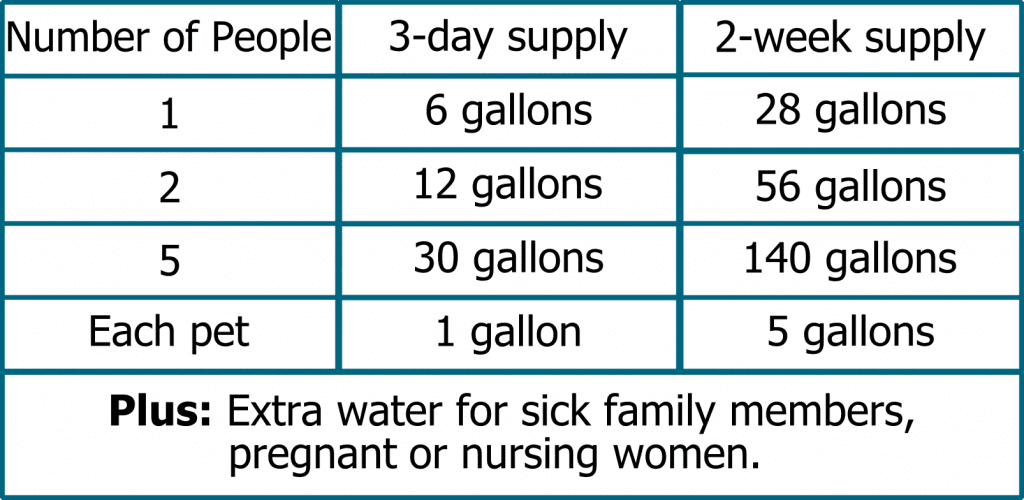

In times of emergency, water is an essential concern. Water is not only essential to good health and hygiene, it is quite often the first thing to be affected by natural disaster. The water supply may be interrupted because of tornado, flooding, extreme weather or a power outage that affects water delivery. Or water may become unsafe when a chemical spill contaminates the water source, or the local water treatment is compromised. These emergencies almost always occur without warning, so now is the time to prepare.
How much should I store?
A person can go without food for as long as three weeks but can die after just three days without water. Most communities are able to restore water within 3-4 days after a disaster. So, you should plan to store enough water for three days minimum, preferably 5-7 days.
To meet your body’s basic needs, most experts recommend two gallons per person per day. That means that a 5-day supply of water would be 10 gallons per person. The ideal is to have a week’s supply of potable (safe to drink) water. But for starters, you should at least make it a goal to have a three-day supply.
Water is also vital to good hygiene. Disease always takes a terrible toll during a natural disaster. The best way to prevent disease during a crisis is to practice good hygiene, starting with frequent and thorough hand washing. That's why it's a good idea to have another 1-2 gallons per person per day for washing and hygiene. But this water does not need to be potable. You do not need to store non-potable water in food grade containers. Personally, I store my non-potable water in empty liquid laundry soap containers. Every time I empty a container of laundry soap, I rinse it well, fill it up with tap water and store it in the basement.
Keep it simple
The simplest way to have stored water is just to go buy a couple cases of bottled water. It's super easy to do and doesn’t cost a lot. But you may find that it takes up a lot of room and it’s not so convenient once you start having to open dozens of bottles to cook a meal.
If you have a larger family, you might buy a 5-gallon jug of purified water. There are some very nice storage racks that let you neatly store several 5-gallon jugs.
You can always store tap water in something as simple as empty vinegar jugs. The one-gallon jugs that vinegar comes in are a heavy food-grade plastic. Just fill them up with water from the tap, add a few drops of bleach (see chart) and set aside. There! You’re done. It couldn’t be easier.

If you have a larger family, you might store water in a 5-gallon bucket. Many bakeries and restaurants give away plastic 5-gallon buckets. These were used to store pickles or other food ingredients, so they are sturdy and food grade. But they may smell of pickles or vanilla, so wash them well. Let them soak for a couple hours with a solution of 2 cups of vinegar or bleach to get the residue out of the plastic. The vinegar is cheaper. It cuts through most oils and is non-toxic. But since you may want to rinse the bucket with a sanitizing bleach solution, maybe you’ll prefer to soak the whole bucket with a bleach solution.
Do not store water in empty plastic milk jugs or 2-liter pop bottles. This kind of plastic degrades over time. One day you’ll go into your storage room to inspect your water storage and you will find a bunch of empty jugs. If you’re lucky, the water will have slowly evaporated through very small holes. If you’re not so lucky, the jugs will develop large holes and you’ll have a soaking wet floor.

Clean containers for clean water
Whatever you choose to store water in, it must be food grade and should never have been used to store any kind of chemicals or non-food items. And make sure that it is very clean. Rinse your containers with a disinfecting solution of 1/2 cup bleach to one gallon of water.
Fill clean containers with water. Either tap water or filtered water will do. Then add a few drops of bleach (see chart). If you are certain that your purified water has been stored in clean containers, there’s nothing more to do. It will store indefinitely. However, over time it will begin to taste flat. You can correct this by aerating the water, pouring it back and forth between containers, several times.
Easy, fast and inexpensive
Don’t leave this essential ingredient to your emergency plans up to chance. Fortunately, this is one of the fastest and easiest components of emergency prep that you can do. And it's super inexpensive. Since May is a busy month with end-of-school activities, graduations, holidays and planting a garden. That makes a goal that's easy to reach, like storing water, a perfect fit for this month.